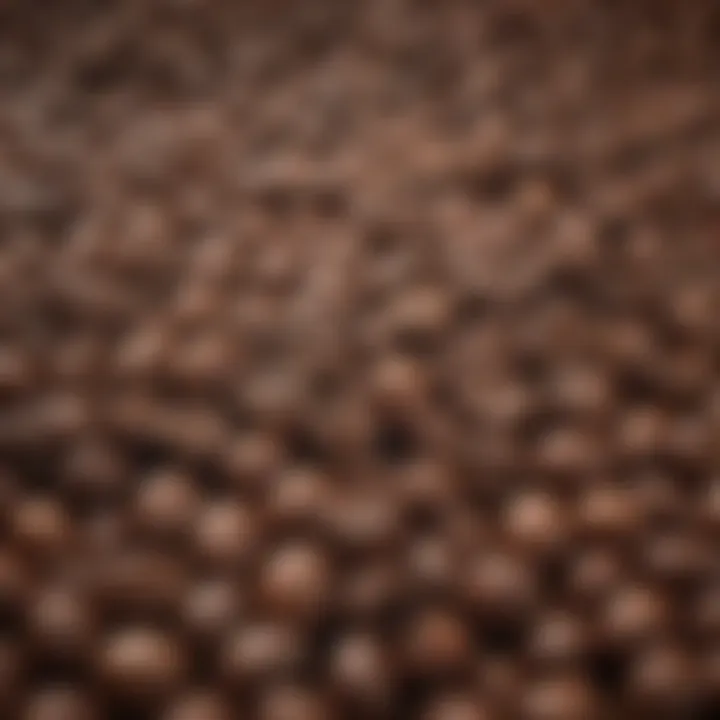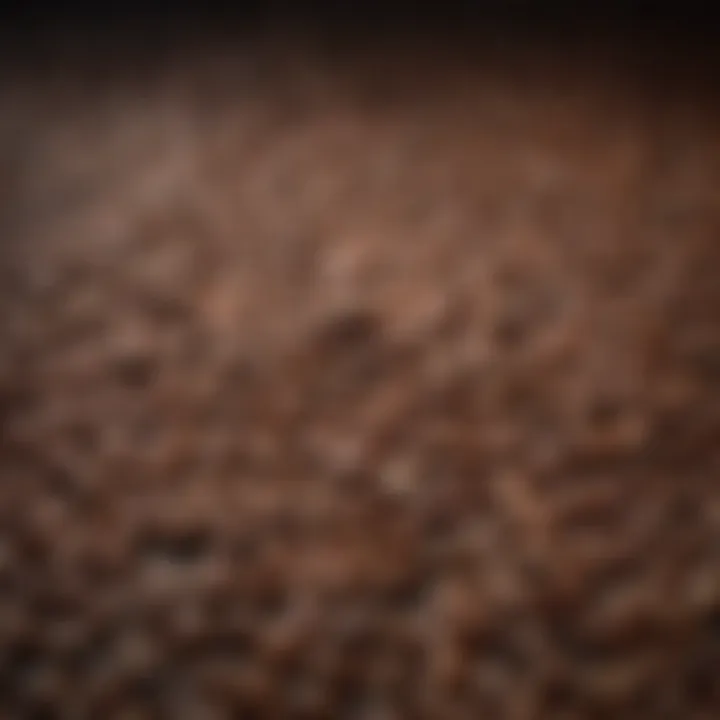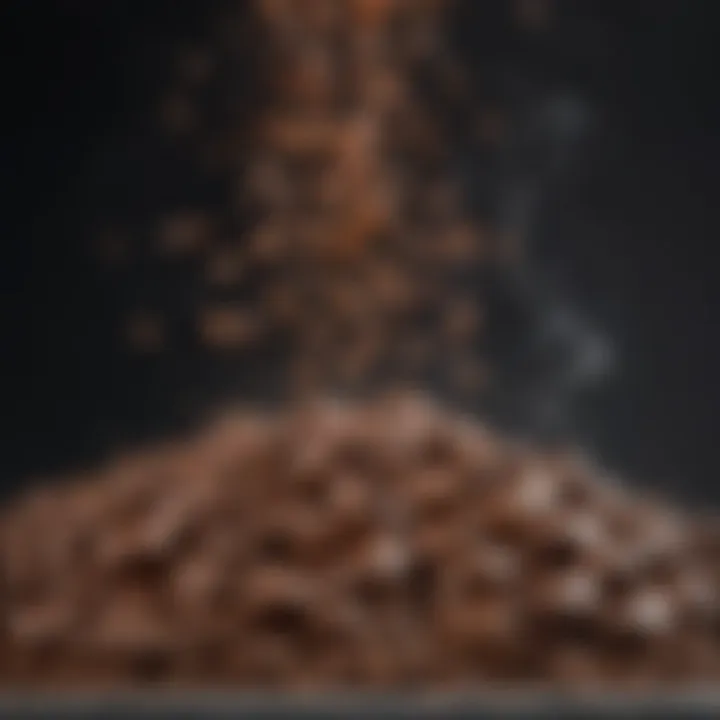Discovering High-Caffeine Coffee Bean Varieties


Intro
Understanding caffeine concentration in coffee beans is essential for enthusiasts and casual drinkers alike. Coffee is more than just a beverage; it is a rich tapestry of flavors and effects primarily dictated by its caffeine content. Identifying which beans have the highest levels of caffeine can wholly change the way one approaches their daily brew.
Caffeine content varies significantly among different coffee bean varieties. Beans like Robusta typically have higher caffeine levels compared to Arabica. This is due to various factors encompassing the beans' genetics as well as their growing conditions. Additionally, roasting and brewing methods play an important role in determining how much caffeine remains in your cup.
Here, we will offer insights not only into specific beans that boast higher caffeine percentages but also delve into the cultivation practices and preparation techniques that enhance these characteristics. By the end, you will have a comprehensive toolkit for maximizing your coffee drinking experience according to your caffeine preferences.
Key Points Covered
- Types of coffee beans with higher caffeine.
- Cultivation and growing regions for these beans.
- Roasting methods that influence caffeine retention.
- Effective brewing techniques to extract peak caffeine levels.
As we embark on this rich exploration of coffee beans, our guide aims to equip you with a new level of appreciation for your coffee continuum. Enjoy this journey into the elevated caffeine landscape of your favorite morning ritual.
Foreword to Caffeine in Coffee
Caffeine serves as a crucial and energizing component of coffee. It is what drives coffee’s popularity and has scientific backing in how it interacts with the human body. This section unpacks caffeine, discussing its origins, its effects, and why its concentration matters. Discussing caffeine potency assists enthusiasts in making informed choices about their coffee selections, impacting their mood and alertness levels.
Understanding Caffeine's Role
Caffeine is an alkaloid found primarily in coffee beans. It acts primarily as a central nervous system stimulant. When consumed, caffeine blocks the adenosine receptors in the brain, leading to increased alertness and reduced perception of fatigue. Many seek coffee for these very effects. Some studies suggest that moderate caffeine intake may even enhance cognitive performance and improve concentration.
Naturally, coffee varieties differ in their caffeine content. Thus, understanding how varying types of beans contribute to caffeine levels can engage consumers to explore their options better. In daily life, caffeine can be very important, assisting many people in staying productive during long hours of work or study.
Importance of Caffeine Concentration
The caffeine concentration in coffee influences an individual’s experience. Coffee beans vary significantly in caffeine levels due to factors like their species and growing conditions. Higher caffeine concentrations might appeal to individuals who drink coffee for instant energy.
Many prefer java with elevated caffeine levels as it provides a stronger and more intense flavor. However, not every method of brewing draws out caffeine equally; some techniques can yield a richer brew, filled with more stimulating compounds. Recognizing the significance of caffeine concentration empowers consumers to choose exactly how much energy they can gain from their cup.
Types of Coffee Beans
Understanding the different types of coffee beans is critical for comprehending which ones offer the highest caffeine content. The nuances in flavors, fragrance, and stimulating properties vary significantly among different beans, creating varied experiences for consumers. The knowledge of each type can equip coffee enthusiasts to make informed choices aligning with their taste preferences and caffeine needs. Aberrations in caffeine levels can genuinely transform the consumption experience, paving the way for careful selection between distinct coffees to find one with the preferred caffeine concentration.
Arabica Beans Overview
Arabica beans are among the most popular varieties available globally, known for their smoother taste and complex flavors. These beans typically have about 1 to 1.5% caffeine content, significantly less than the Robusta variety. Arabica coffee tends to thrive in higher altitudes with cooler climates, which influences not only its unique flavor profile but also its growing challenges, often resulting in higher prices.
The subtle sweetness, accompanied by fruity and floral notes, makes Arabica appealing. However, it lacks the robust kick that many coffee drinkers may desire if opting for high caffeine content. Thus, while Arabica is a staple in macchiatos and lattes, its lower caffeine may or may not be a deciding factor for enthusiasts seeking that potent punch in their java.
Robusta Beans Overview
Robusta beans are significantly different from Arabica. Originating from Africa, these beans typically contain between 2.2 and 2.7% caffeine. Their cultivation is often easier, as the plants are more resilient and can prosper at lower elevations and in hotter climates. This resilience translates into a lower market price, making Robusta an sought out creation for both espresso and instant coffee.
The flavor profile of Robusta is often described as earthy, woody, or nutty, lacking the brightness found in Arabica. The high caffeine content can contribute to a thicker crema, a desirable characteristic in espresso preparation. For those prioritizing stimulation from coffee consumption, Robusta may be an excellent choice, whether enjoyed alone or blended.
Liberica and Excelsa Beans
Liberica and Excelsa are less commonly discussed but continue to offer unique attributes worth examining. Liberica beans are notable for their irregular shape and distinct aroma that can be described as floral and fruity. With a caffeine content similar to Arabica, they possess a unique sweetness that leads them to be embraced by a niche market. Experiments with Liberica are often limited, leading enthusiasts on a quest for a flavor profile that celebrates the unconventional.
Excelsa, classified under Liberica, is primarily grown in Southeast Asia. They contribute a light, fruity profile and bold acidity to blends. The caffeine levels are also similar to Arabica but do not overshadow the vivid taste complexity offered. Specialized coffee shops sometimes utilize these beans in unique blends to appeal to those pursuing new sensory coffee experiences.
Overall, the array of coffee beans each provides an array of caffeine and flavor for aficionados to ensnare their palette.
Understanding each type of coffee bean enables the discerning drinker to appreciate the diverse flavours while also aligning with specific caffeine needs.
Coffee Beans with the Highest Caffeine Content
Understanding the types of coffee beans known for high caffeine levels is significant for both the caffeine enthusiast and the casual consumer. Caffeine concentration directly impacts the flavor and strength of a cup of coffee, affecting the overall experience. Certain beans naturally possess higher caffeine content, and recognizing these varieties can greatly enhance one's enjoyment and appreciation of coffee. Furthermore, knowledge about caffeine-rich beans may contribute to informed choices regarding health and energy levels.


High caffeine content in coffee beans can bring several benefits:
- Flavor Profile: Beans with elevated caffeine levels often have a bolder taste.
- Energy Boost: Higher caffeine facilitates energy levels, stimulating alertness and productivity.
- Variety Range: Exploring these types leads to discovering unique brewing methods and blends.
In the next sections, we will analyze some of the top coffee bean varieties with significant caffeine concentrations and broaden our understanding of specialty blends that emphasize caffeine extraction.
Robusta Varieties
Robusta coffee beans are renowned for their caffeine content, often containing about twice the caffeine of their Arabica counterparts. Botanical characteristics and the growing conditions of Robusta beans contribute to this potent caffeine level. Typically, it’s grown in lower altitudes and hotter climates, enhancing its caffeine percentage as a natural defense mechanism against pests and diseases.
Characteristics of Robusta beans include:
- Flavor: Typically have a stronger, more bitter flavor than Arabica beans.
- Physical Attributes: They are round and smaller compared to Arabica beans, which are oval and broader.
- Caffeine Levels: Higher average levels of caffeine provide robust tastes and stimulating effects.
Some popular varieties of Robusta beans include the Indonesian robustas and the Brazilian robustas. Using these beans in blends or ales can significantly raise the caffeine content of the final brew. Coffee drinkers who seek a greater intensity or 더욱 에너지를 느끼는 경험을 원한다면, Robusta bean 옵션이 도움이 될 수 있습니다.
Specialty High-Caffeine Blends
In the realm of specialty coffee, there are various blends that creatively combine different beans to boost caffeine levels without compromising flavor. Specialty high-caffeine blends often include rare varieties, such as Coffea canephora and specific hybrids designed to enhance caffeine output.
Benefits of these blends:
- Customization: These blends can cater to different taste profiles while still maximizing caffeine content.
- Unique Experiences: Roasters frequently experiment with processing techniques to elevate the caffeine kick alongside flavor intricacies.
- Innovation: New coffee product developments often integrate robust beans into unique blends, encouraging innovative practices around caffeine extraction.
Additionally, specialty coffee brands like Death Wish Coffee and Black Insomnia Coffee market blends specifically highlighted for high caffeine levels. They balance components that appeal to traditional flavors with exceptional energy potential—attracting a clientele that appreciates potent gastronomy alongside everyday practicality.
To some, the conquest of caffeine content is an ongoing journey, revealing layers of growth in personal taste.
In summary, both Robusta varieties and specialty high-caffeine blends make up a significant part of the coffee landscape, enabling enthusiasts to experiment with richer flavors and stronger effects while enjoying each cup. Understanding these categories enhances one's coffee selection for an energizing experience.
Impact of Growing Conditions on Caffeine Levels
Understanding how various growing conditions influence the caffeine levels in coffee beans is crucial for anyone seeking high-caffeine coffee. This part of the article focuses on specific elements such as climate, altitude, soil composition, and their benefits in enhancing the caffeine concentration of coffee beans. The conditions under which coffee is grown can affect not only the flavor profile, but also the chemical composition, including caffeine content. Selecting the optimal variables can lead to superior beans that provide a rich and highly caffeinated experience.
Climate and Altitude Effects
The climate in which coffee is cultivated has a significant impact on caffeine content. Coffee plants benefit from mild temperatures and moderate rainfall, with essential sunlight being just as crucial. Subtropical regions are often ideal. They provide conditions that allow the coffee beans to develop their full potential.
Elevation plays a vital role as well. Coffee grown at higher altitudes typically experiences cooler temperatures. This cooler climate tends to slow down the growth rate of the beans. As a consequence, the coffee plants invest more resources in stress hormones, which raise caffeine levels to protect against pests and diseases.
Research shows a direct correlation between altitude and caffeine content. Coffee grown at altitudes above 1,200 meters often shows an increased caffeine concentration compared to lower elevations. This is due to the longer maturation period required, leading to more potent beans.
Soil Composition and Fertility
The soil's composition plays a vital role in how coffee plants absorb nutrients. Nutritionally rich soil leads to healthier plants. This is significant because coffee plants under stress often generate higher amounts of caffeine as a defensive measure. Good soil fertility increases the resilience of coffee plants, consequently affecting caffeine content.
Ideal soil conditions often feature good drainage and high organic matter. This promotes root growth, allowing plants to absorb more essential nutrients. Organic matter also directly reinforces microbial activity, which contributes to soil health.
Key breaks down certain elements:
- Nitrogen: Higher levels can boost plant growth but too much can lead to reduced caffeine.
- Phosphorous: Essential for root and berry development, which impacts overall yield.
- Potassium: Increases coffee quality, influencing acidity and aroma, significantly affecting caffeine concentration.
By carefully managing soil parameters, cultivators can optimize the growing terrain. Thus, enriching the caffeine profile of their coffee effectively.
Understanding these growing conditions is essential for coffee producers seeking to enhance the caffeine profiles of their beans.
The Roasting Process
Roasting serves as a critical phase in coffee production. It transitions green beans to their rich brown forms, imparting flavor and aroma essential to the coffee experience. Notably, roasting also influences the caffeine content in brewed coffee, shaping how coffee drinkers engage with their beverages.


Roasting coffee beans involves heating them to high temperatures. As temperature rises, numerous chemical changes occur. These changes enhance both flavor profiles and caffeine stability. Therefore, understanding the roasting process is essential for anyone interested in the characteristics that caffeine-rich coffee embodies.
How Roasting Affects Caffeine
You might wonder, how does roasting truly impact caffeine levels? Surprisingly, coffee enthusiasts often confuse roasting levels with actual caffeine content.
While caffeine is impacted by roast duration and temperature, it's crucial to understand that the roasting process does not significantly alter the overall caffeine content of the beans themselves. Here's some key information:
- Caffeine Stability: Caffeine remains relatively stable during the roasting process, meaning that whether beans are dark or light roasted, the starting caffeine content is largely retained.
- Loss in Mass: Dark roasting can result in slight loss of mass due to evaporation; depending on the initial water content, the concentration might seem to change, especially in relation to shorter brewed coffee methods.
- Potential Myths: Many believe dark roasts contain more caffeine than lighter roasts. However, this is often misleading due to differences in volume and weight after roasting.
This means roasters and coffee lovers must critically analyze methods of preparation instead of relying solely on roast levels when considering caffeine intake.
Light vs.
Dark Roasting Effects
The choice between light and dark roasting affects not only flavor profiles but also aspects of caffeine extraction during brewing processes. Below are some distinctions:
- Light Roasting: Usually involves a short roasting time that reserves more original flavor characteristics. When brewed, light roasts tend to have bright acidity and complex flavors. They often contain slightly higher moisture and density, which can influence caffeine extraction positively during certain brewing methods.
- Dark Roasting: This method enhances the bitterness and deep body of the flavor; it often brings out chocolaty or smoky notes. Dark roasts, though containing similar caffeine ratios as light roasts, might result in greater caffeine extraction based primarily on brew technique.
A good takeaway from this is the realization that all beans relate back to their origins. Different sugars develop through each roasting, influencing how flavors and caffeine manifest during preparation.
“The choice of roast level can either highlight or mask the inherent caffeine challenge presented by the bean.”
In summary, while roasting affects how coffee tastes, the caffeine content remains relatively stable and plays a significant role in the final cup performance based on brewing techniques and processes implemented downstream. Understanding these nuances can empower consmumers to make informed choices about their coffee for not just caffeine need but flavor satisfaction as well.
Brewing Methods to Maximize Caffeine Extraction
Brewing methods play a crucial role in determining the caffeine content in coffee. Each technique extracts different flavors and compounds from the coffee beans. For those who seek to optimize their caffeine intake, understanding these methods and their mechanics is essential. Knowing the best practices can lead to a more robust coffee experience that truly satisfies caffeine cravings.
Espresso Preparation Techniques
Espresso is recognized for its concentrated flavor and caffeine potency. Proper preparation is vital for maximizing caffeine extraction. The following aspects are essential:
- Grind Size: Using a fine grind allows more surface area to be exposed to water, leading to better extraction.
- Pressure and Temperature: High pressure (around 9 bars) and optimal temperature (around 90-96°C) during brewing pushes hot water through the grounds effectively, enhancing caffeine extraction.
- Brew Time: A short extraction time of about 25-30 seconds is ideal for espresso. This quick process captures the desirable oils and caffeine without over-extraction of bitter compounds.
By focusing on these elements, one can brew an espresso shot with high caffeine concentration, making it a popular choice for caffeine enthusiasts.
French Press Best Practices
French press is another method that can yield a high caffeine content if utilized correctly. Attention to detail during the process will efficiently extract caffeine and other flavors:
- Coarse Grind: A coarse grind is necessary as it helps prevent over-extraction. It also makes the filtration process smoother.
- Steeping Time: steepping coffee for around 4 minutes is optimal for balancing flavor and caffeine. It allows ample time for the caffeine to leach into the water.
- Water Ratio: The standard ratio of coffee to water in a French press should be about 1:15. Adjusting this ratio can alter the caffeine strength significantly; stronger mixes generally lead to higher caffeine content.
A well-brewed French press coffee will showcase rich flavor while packing a solid caffeine punch.
Cold Brew Variables
Cold brew has gained attention for a smoother coffee experience that can be rich in caffeine as well. Several variables influence caffeine extraction:
- Brewing Time: A longer brewing process, ideally 12-24 hours, allows for gradual extraction of caffeine without heat, which can yield a robust flavor.
- Coffee Concentration: Using a higher coffee-to-water ratio, such as 1:4, can drastically increase caffeine levels in the final brew.
- Temperature: Cold brewing typically occurs at room temperature or in the fridge. Brewing colder can lead to a different extraction profile, often allowing mellow flavors with strong caffeine intensity.
Home brews prepared with attention to these positions can deliver a highly caffeinated and pleasant coffee that many enjoy.
Key Insight: The choice of brewing method greatly influences the amount of caffeine extracted from coffee beans. By mastering these techniques and understanding their intricacies, coffee drinkers can customize their caffeinated experiences to match their preferences.
Through espresso, French press, or cold brew, high caffeine concentrations can be successfully achieved, meeting the desires of culinary enthusiasts steadily.
Analyzing Caffeine Content in Coffee


Understanding caffeine content is crucial for coffee enthusiasts and professionals alike. This section will explore how caffeine concentration affects taste and overall experience. Not all coffee is created equal, with distinct varieties and brewing methods influencing the caffeine we receive from each cup.
In analyzing caffeine content, one must remember that variations exist due to numerous factors like growing conditions, genetic makeup of the beans, and processing techniques. A precise measurement system helps identify the strongest brews and tailor coffee choices to personal preferences.
Measuring Caffeine Levels
There are different techniques used in measuring caffeine levels in coffee. Precision is key to understanding the true caffeine content of various types of coffee. Common methods include:
- Laboratory Analyses: Involves complex equipment and skilled technicians to obtain accurate results.
- Home Kits: While less precise, they allow coffee lovers to gauge caffeine content on their own.
- Published Research: Studies that explore caffeine content across various bean types or brewing methods can be an informative resource.
Most often, caffeine measurement is presented in milligrams per 8-ounce servings. Arabica beans typically hold around 95mg, while Robusta can deliver between 140mg to 200mg. Within these categories, it is essential to respect the chosen brewing technique, since it can amplify or reduce caffeine extraction.
Understanding Caffeine Variability
Caffeine variability can stem from a multitude of factors. Some aspects that contribute to different caffeine levels include:
- Bean Type: Variance exists inherently between Arabica and Robusta beans; as mentioned, Robusta generally possesses more caffeine.
- Growing Region: The altitude, climate, and soil health impact caffeine synthesis in plants. Beans grown at higher altitudes often showcase unique flavors and varying caffeine concentrations.
- Processing Method: The processing step after harvesting can influence caffeine retention. Wet and dry methods yield dissimilar results.
- Roasting: The roasting level plays a key role as prolonged heating usually encourages a marginal reduction in caffeine. Dark roasts have slightly lower caffeine than light roasts due to the chemical reactions occurring during cooking.
High variability means that one coffee's caffeine level cannot straightforwardly be compared with another without confirming the methods of production and preparation.
By measuring and understanding these variables, coffee drinkers can guide their choices, ensuring they consume the right amount of caffeine that fits their menu or mood. Accurate analysis leads to enjoyment and enhances knowledge surrounding caffeine-rich coffee options.
Useful Resources
- Learn more on Analyses process
- Science behind Coffee and Caffeine
- Discuss various brewing methods
- Engage with coffee communities
Health Considerations Related to High Caffeine Intake
Understanding the impact of caffeine consumption is crucial for any coffee enthusiast. High caffeine intake can provide numerous advantages but also involves important health considerations. It is vital to approach caffeine not just as a stimulant but as a compound that impacts health in various ways.
Caffeine Tolerance and Sensitivity
Caffeine tolerance is a fascinating topic. Over time, regular caffeine consumption can lead to reduced responsiveness to its effects. This means that the body adapts to higher levels, needing more caffeine to achieve the same alertness. Significant factors influence this, including genetic predisposition, metabolic rates, and even individual lifestyle choices.
People who have a higher tolerance might consume heavier amounts without experiencing jitters or anxiety. On the other hand, individuals sensitive to caffeine may experience higher adverse effects, including restlessness, heart palpitations, or sleep disturbances even with small amounts. Understanding one’s own tolerance or sensitivity towards caffeine is fundamental to enjoying coffee without unwanted outcomes.
Potential Health Benefits
Research shows that moderate caffeine consumption can offer various health benefits.
- Enhanced Mental Alertness: Increased awareness and cognitive performance are often cited benefits of caffeine.
- Reduced Risk of Certain Diseases: Studies indicate that coffee drinkers might have a lower risk of developing certain types of Parkinson's disease and Type 2 diabetes.
- Metabolism Boost: Some analyses suggest caffeine encourages faster metabolism, aiding in weight management.
Each of these potential benefits speaks to the complex relationship between coffee consumed in moderation and overall wellbeing.
Risks of Excessive Consumption
Despite benefits, excessive caffeine intake carries risks that can outweigh its positives. Amounts over the widely accepted limit (around 400 mg per day for most adults) can lead to negative outcomes, including:
- Anxiety Disorders: Overconsumption can trigger considerable anxiety in some individuals.
- Sleep Disruption: High caffeine intake, especially later in the day, can interfere with sleep patterns and lead to insomnia.
- Dependence: Relying heavily on caffeine can lead to dependence, with withdrawal symptoms like headaches and irritability arising from sudden cessation.
It is essential to find a balance in caffeine intake for optimal health benefits without turning towards excessive consumption, which could carry significant risks.
Each of these health considerations forms a comprehensive understanding of how to enjoy coffee while maximizing its fitness benefits and minimizing possible downsides. Monitoring one's intake and adjusting consumption according to individual tolerance can lead to a healthier relationship with coffee.
Epilogue
Recap of Key Points
- Caffeine's Role: Caffeine serves as both a stimulant and a beneficial compound in coffee; understanding its concentration in different beans is important for selection.
- Types of Beans: Arabica, Robusta, Liberica, and Excelsa each provide unique taste profiles and varying caffeine levels.
- Growing Conditions: The environmental factors such as climate and soil can notably impact the caffeine content found in beans.
- Roasting and Brewing: How beans are roasted and brewed significantly alters caffeine extraction from the coffee, impacting the beverage's overall strength.
- Health Considerations: Taking into account personal tolerance and potential risks related to high caffeine intake is essential.
Final Thoughts on Caffeine in Coffee
Exploring caffeine in coffee transcends tea preference and symbolizes a comprehensive journey into the complexity of flavors and sensations. As caffeine continues to draw interest for its unique properties, this knowledge can play a pivotal role in enhancing one’s appreciation for coffee culture. Choosing beans like Robusta varieties known for their higher caffeine, appreciating the exacting process of roasting, and understanding varied methodologies of brewing can greatly enrich one's coffee experience.
Coffee is more than a drink; it is a ritual, a way to connect with both flavors and feelings.
In every sip, the pursuit for distinct qualities mirrors the diverse preferences among coffee drinkers. A mindful approach to selection leaves room for exploration in taste and caffine intensity while engaging with broader implications of health and preference.







